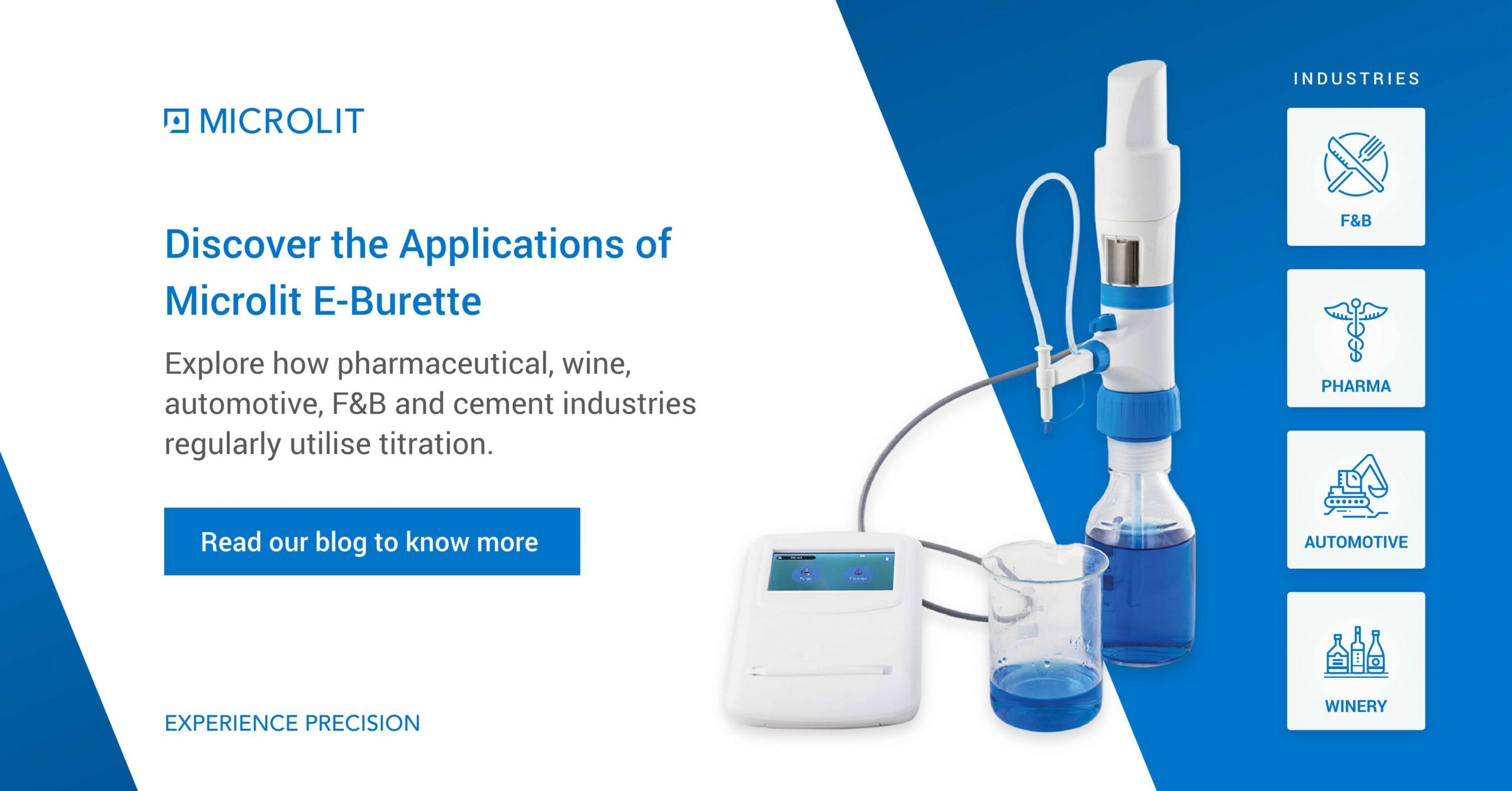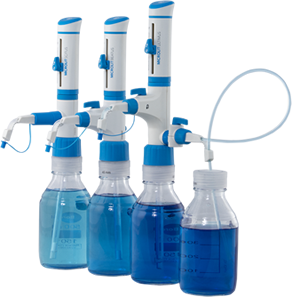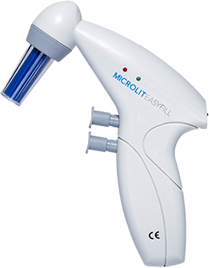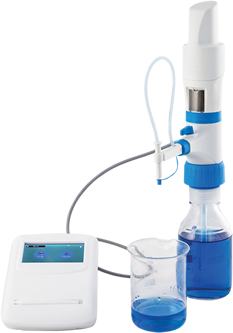What is an E-burette?
A piece of state-of-the-art lab equipment, the e-burette designed by the product engineers at Microlit offers sophisticated features and functionality like – motor controlled piston movement, touch screen enabled control panel with graphical user interface (GUI), one-touch filling operation and three calibrated preset speeds to perform highly accurate titrations.
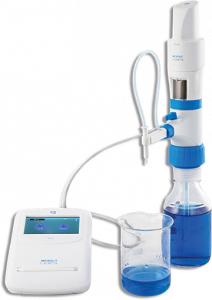
The e-burette is commonly used to carry out titrations. Titration is a quantitative chemical analysis where a solution of known concentration is used to determine the concentration of an unknown solution. The titrant (the known solution) is added to a known quantity of the analyte (the unknown solution) until the reaction is complete.
The titration process is of four types –
-
Acid-base Titration
The acid-base titration enables the user to determine the strength of an acid or a base. For acid, the strength can be determined by using a standard solution of a base which is known as acidimetry. Whereas, for a base, the strength can be found out with the help of a standard solution of an acid known as alkalimetry.
-
Redox Titration
Also known as an oxidation-reduction reaction, redox titration is a chemical reaction that takes place with a transfer of electrons in the reacting ions of aqueous solutions. The titrations are named after the reagent used, and are as follows:
- Permanganate Titrations
- Dichromate Titrations
- Iodimetric and Iodometric Titration
-
Precipitation Titration
The precipitation titration is based on the precipitate formation when two reacting substances are brought in contact with each other.
-
Complexometric Titration
A titration where an undissociated complex is formed at an equivalence point is known as complexmetric titration. This titration process is free from errors due to co-precipitations and is greater than precipitation titrations.
The process of titration is widely used in various industries. Listed below are its various industrial applications.
Pharmaceutical Industry
The pharmaceutical industry is the enabler of discovering, developing, producing, and marketing drugs to be used as a medication for patients, with the sole aim of curing or vaccinating them, or alleviating the symptoms.
For the development of medications, a particular quantity of chemicals is to be determined. This measurement of the quantity of the chemicals is finalised by the process of titration. There are various titration procedures used in the pharmaceutical industry.
- Purity analysis often uses acid-base titration.
- Content analysis is done through redox titration to establish the purity of the raw material.
- Precipitation titrations facilitate the formation of a solid product.
- pH-stat titration is used to determine the acidity of the drugs, check the purity of enzymes and investigate the speed and other characteristics of the chemical reactions.
Wine Industry
The wine industry, ignored or banned in certain countries, is a significant business sector. The industry is large and is growing consistently. Quality and chemical precision are paramount in the wine industry and titration is used to determine the acidity and evaluate the content of sulfur dioxide.
Vintners (winegrowers) use titration throughout the winemaking process. It allows them to check the quality of raw materials used for production and bring out the flavour of the wine. Titration also helps to check the batch while fermentation is taking place, and the same is used for final quality control.
Automotive Industry
One of the largest industries by revenue, the automotive industry comprises various organizations that are involved in the design, development, manufacturing, marketing, and selling of vehicles. The automotive industry uses the titration process for the production of biodiesel oil.
The biodiesel oil is required to have a particular pH level to ensure its functionality. For this purpose, titration comes in handy. Manufacturers measure the pH level of biodiesel and then determine the amount of base to be used to achieve the desired pH level. During this process, the concentration of biodiesel, the concentration of base and the exact volume of the fuel are known, determining the correct volume of the base required to make the fuel easy.
Food & Beverage Industry
The F&B industry comprises all the companies that are involved in the processing of raw materials, packaging and distribution. This includes fresh, prepared food as well as packaged food, and alcoholic and non-alcoholic beverages. The industry uses the technique of titration for mainly two purposes – regulatory requirements and quality control.
It has been mandated by respective regulatory bodies that all food labels should state the content of sodium, calcium and iron. Hence, every manufacturer must test and measure the quantities of these minerals. The presence of these minerals is determined by precipitation and complexometric titration.
The manufacturers use acid-base titration for quality control. It is important to regulate the taste, texture, nutrition, stability and appearance of food. Acidity in food is a major deciding factor of the bitterness of a food item or a beverage. By performing an acid-base titration, manufacturers can determine the amount of acid in their product and regulate the flavour of the product. This also enables the manufacturers to ensure that the taste of the product is similar across all batches.
Cosmetic Industry
The cosmetic industry has witnessed an explosive boom in recent times, especially among the young, independent brands. The industry manufactures and distributes cosmetic products including, colour cosmetics and toiletries.
There are always certain chemicals used for the production of cosmetics. But, the manufacturers need to add appropriate concentration and amount of chemicals to ensure that it does not cause any harm to the user. This is where titration is used. The process of titration also enables the manufacturers to determine the best suitable base for cosmetics, for instance, coconut oil is used as a base in many products.
Visit Burette page to know more about the Microlit E-Burette.
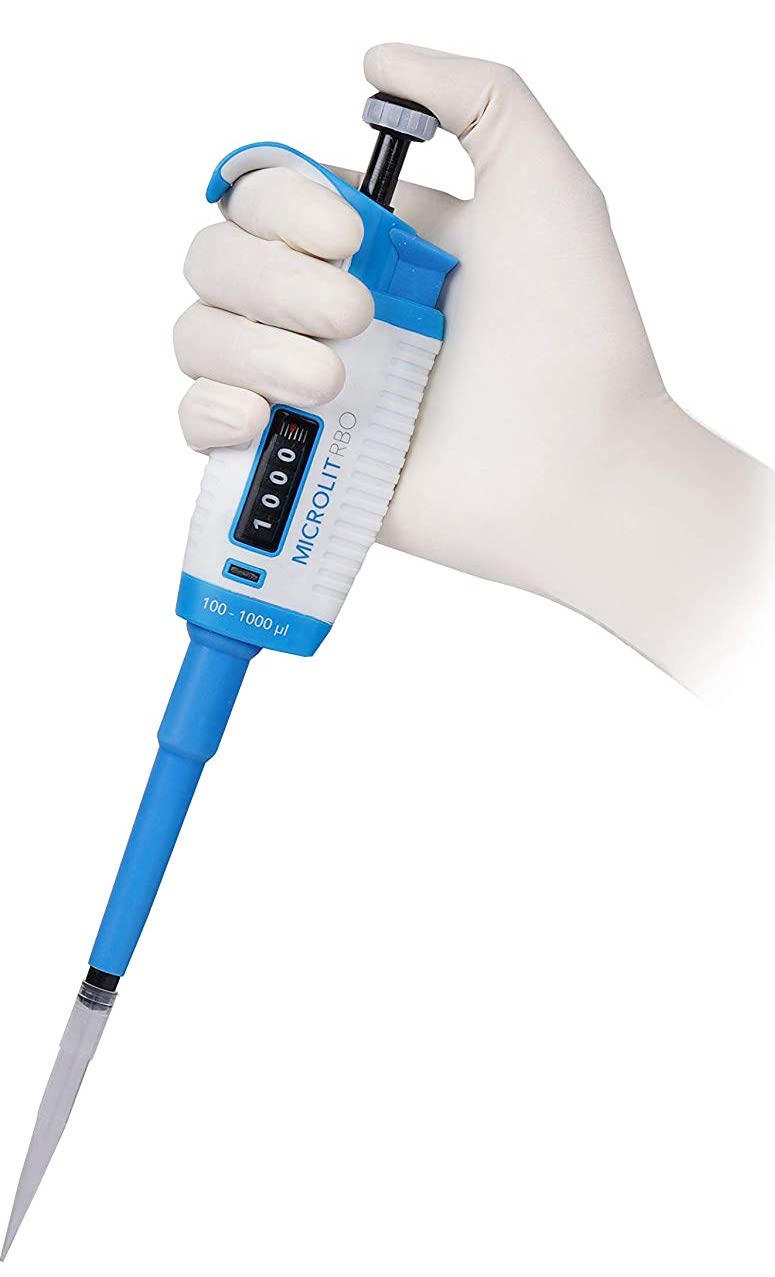





 10072
10072